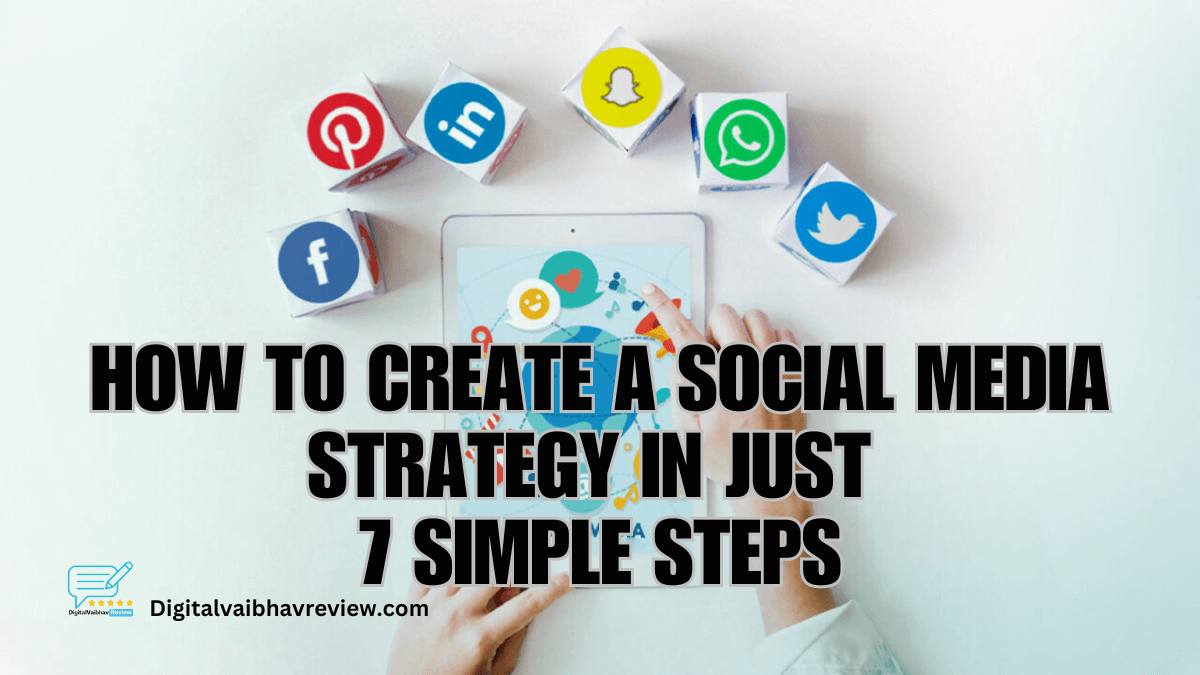How to Create a Social Media Strategy in Just 7 Simple Steps? Should that be your inquiry, I possess the response.
You will have an effective social media marketing plan by the end of this article, even if you have no prior experience. This strategy should increase your visibility and sales.
What’s the best part? The majority of these strategies are completely free and only require minor adjustments.
How to Create a Social Media Strategy in Just 7 Simple Steps
These 7 steps will help you create a social media strategy to drive the best results.
Let’s get started.
1. Know all your Targets

It’s important to identify your goals before creating a social media strategy and marketing campaign. There are multiple reasons why this information is significant. Meaning
- Your campaign’s goal is: You need to know exactly what you wish to achieve through the campaign. Do you need more likes? Followers? Brand exposure? Sales? Something else? This end goal needs to be crystal clear.
- Your target audience is: You need to have a definite idea of who exactly your campaign is being displayed to. Your target audience decides which content you can or can’t use; hence, clarity is of utmost importance.
- Your target social media platforms are: Not all contents or campaigns suit all platforms. You must decide which platforms you’re targeting. If you’re targeting multiple platforms, that needs to be finalized in advance as well.
Of course, we will discuss how to pick the right social media channels and other factors in the next few sections.
2. Competition Research
Even without having your targets clear, the best way to start is competition research. If you know which brands compete against you, look at their content and targets.
Which audience are they targeting? What does their content look like? Where do the ads lead, and what’s their hook?
Follow competitors’ content by clicking on them and going through their landing pages/sales pitches.
This massively helps you understand who and where your content should be aimed.
3. Craft content “around” your targets
Once you have your targets, you need to start working on the actual content.
- Audience: Understand the age, gender, and location interests of your target audience. Content that suits a 16-year-old female teen may not suit a 60-year-old consumer. Craft multiple content copies if you have to but make sure each content copy has been crafted to serve a specific group of audience members. Include GenZ humor in one and maybe vintage nostalgia in the other, the point is, to make it relevant to each group.
- Platform: Each platform has its own size and other requirements for content. More importantly, each platform has a different kind of audience. So, just because you selected Facebook doesn’t mean you can use whatever content you’ve created on it. Facebook generally has an older audience as compared to Instagram, while LinkedIn has a more professional user base. Keeping these things in mind, your content must be platform-specific.
- Interests: Pay attention to what your audience likes and create similar content.
4. Create brand identity
When you look at content from KFC or Starbucks, you almost instantly know which brand it is. Even without looking at the full contents. This is because they’ve crafted a very specific brand identity.
Regardless of which or how many platforms/contents you’re using, your identity needs to be clear across them all.
There are several ways you can do this:
- Consistent colors: Whatever your brand colors are, be sure to use them consistently for all contents.
- Logos and fonts: Of course, stick that logo wherever you can, and make sure you use the same or similar fonts for all contents.
- Tone or content style: Your content is either funny, smart, just informative, or maybe even bland. The point is, please make sure all your contents have this consistency on all platforms and content copies.
5. Schedule your posts
I’m not asking you to schedule your post because you’re lazy or you’ll forget. Scheduling your post has several other benefits:
- Posts at the same time: Your page will always post your content at the same time (unless you choose otherwise). This is a proven strategy to boost your social media activity, as your followers, after a few posts, almost know subconsciously when your next post will be up.
- Consistency: You’ll never miss posting, even if you’re at the beach sipping Mai Tai.
- Experiment: You can set posts to be published multiple times and see which gets the most engagement.
6. Analyze and monitor

This is a huge thing! Imagine that ten campaigns are active across three platforms. It is necessary to look over the posts to find the effective ones, rejecting the ones that don’t seem to be.
- Timings: If you used the above tip for scheduling your posts, you’ll know which time works best for your audience. Eliminate those timeframes that don’t work.
- Post type: Out of all your content types, a few will always work better than the rest. This depends on multiple factors. Instead of studying the factors, you can simply post more of what works.
- Best platform: You may also look at the best-performing platform. You needn’t necessarily cut off the other platforms unless you’re short on budget.
7. Respond and be active
One benefit of social media content over other types of campaigns is that you get to respond to your viewers. Use that opportunity to the maximum possible extent.
Always check the comments or questions below your content. Also, it’s not smart to employ some automated response system or copy-paste the same answers.
Be human and answer each question with as much “personalization” as possible. Each person who comments is a viewer you can convert into a customer with the right approach.
Also Read: Best Social Media AI Tools 2024
Conclusion
That’s it, everyone. As I finish up, let me clarify that there is no one best way to create a social media strategy.
That mostly depends on your specific offering, target market, platform, level of competition, financial limitations, and final goal.
Of course, if you follow the above suggestions, it will normally benefit you. Additionally, if you continue to analyze and track your campaigns, you will eventually develop the finest potential methods.
